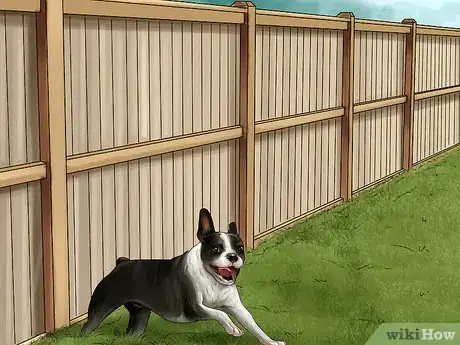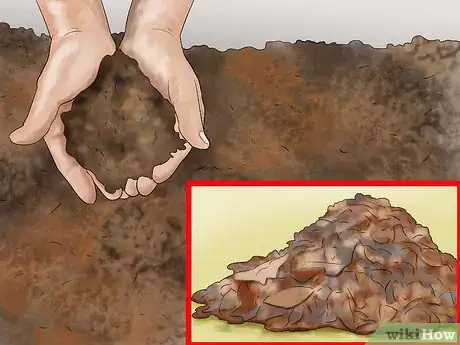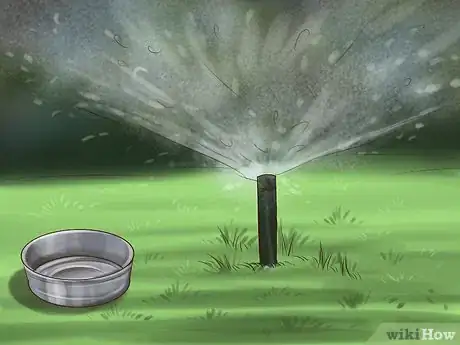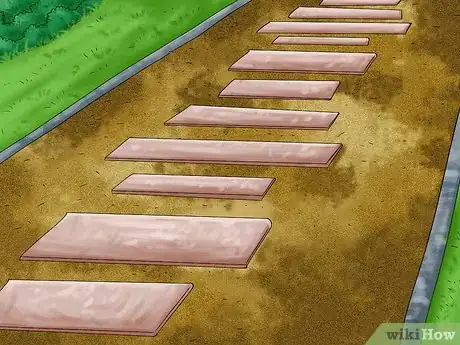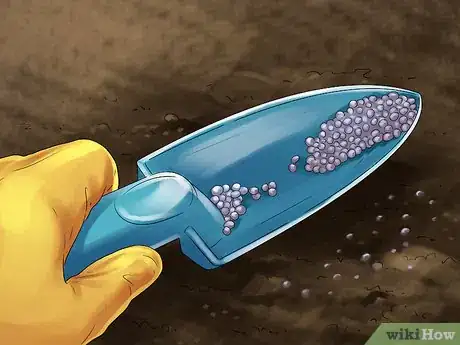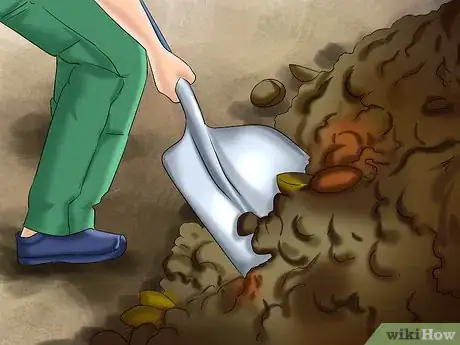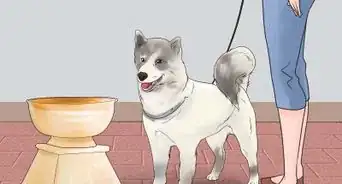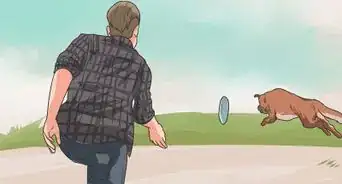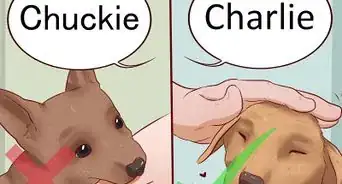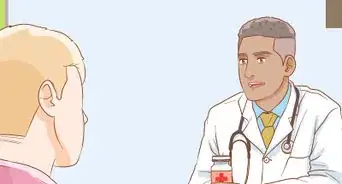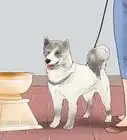This article was co-authored by Beverly Ulbrich. Beverly Ulbrich is a Dog Behaviorist and Trainer and the Founder of The Pooch Coach, a private dog training business based in the San Francisco Bay Area. She is a Certified CGC (Canine Good Citizen) Evaluator by the American Kennel Club and has served on the Board of Directors for the American Humane Association and Rocket Dog Rescue. She has been voted the best private dog trainer in the San Francisco Bay Area 4 times by SF Chronicle and by Bay Woof, and she has won 4 "Top Dog Blog" awards. She has also been featured on TV as a dog behavior expert. Beverly has over 18 years of dog behavior training experience and specializes in dog aggression and anxiety training. She has a Master of Business Administration from Santa Clara University and a BS from Rutgers University.
This article has been viewed 556,188 times.
If your lawn or garden seem to always be the toilet target of your own dog or neighborhood dogs, there are measures you can take to keep dogs at bay. A combinations of barriers, repellents, and distractions can encourage dogs to surpass your garden when seeking relief.
Steps
Putting Up Obstacles
-
1Put up a fence. Perhaps the most obvious solution, if not the most cost effective, is simply fencing in your garden to keep dogs out.
- Make sure your fence is in line with local property laws. Ask neighbors or go to city hall and check in with officials.
- Fences can be an expensive option, but might be worth it if the dogs are not easily deterred. For small dogs, a 16-inch fence border will do. It costs roughly $29 for six feet. However, if you have larger and high energy dogs getting into the garden you might consider caging your garden in a chicken wire fence with a top enclosure.[1]
- Installation can be tricky, particularly if you've never put up a fence solo before. You could consider hiring help, but that can get costly. How-to articles and videos are available online and you can always seek out the help of neighbors, friends, and family members. If the problem dog belongs to a neighbor, you could politely ask them to chip in some for the cost and help get the fence up.
- Keep the gate closed at all time and routinely check for holes and other wear and tear.
-
2Use plant barriers. Aesthetically, many people dislike fencing in their gardens. A plant barrier, meaning planting certain shrubs and flowers around the main garden, may be a more attractive option.
- There are a variety of dog-proof plants. That is, plants that are sturdy and tall enough to withstand a dog's attempt to infiltrate the garden. These include peony, verbena, cone flower, black eyed Susans, Russian sage, and Mexican primrose. If you want other options, ask at your local greenhouse.
- Shrubs are another option for a plant barrier and may provide a more solidified boundary. Laurel, evergreen, huckleberry, and escallonia are good shrub options.
- While thorny or prickly bushes, such as holly and barberry, might seem like a good idea for deterring dogs be wary. These can cause harm to dogs when they attempt to get into the garden. You do not want to accidentally injure a neighbor's pet.
Advertisement -
3Create a barrier with gravel or mulch. You can also create a mote-like barrier encompassing the garden using gravel or mulch, textures dogs generally avoid treading on. This will deter the dog from entering your garden to defecate.
- There are a variety of mulches available at hardware stores and greenhouses. Select a mulch that will be uncomfortable for a dog to walk over without harming the dog. One made from pine cones or pine needles is a great option.
- Decorative gravel, preferably with sharp edges, can also be purchased at hardware stores and greenhouses. Dogs will avoid walking on gravel because of the discomfort it causes to their pads. However, the one downside to gravel is that many people find it ugly. If you're unsure of using gravel due to aesthetic preferences, you can try to build a rock garden instead. However, the intended effect might not be as great as dogs can more easily navigated loosely collected rocks and stones.
-
4Invest in sprinklers. A sprinkler system can be a great way to scare dogs off your property. They will learn to avoid an area where they occasionally get wet.
- A motion activated sprinkler is probably your best option. You can find one at a department store or on Amazon. This will be set off when motion is detected, so it will automatically fire cold water when a dog enters your garden.
- Dogs will learn to associate your yard with an unexpected dousing of water. Eventually, they will learn to stay away.
Creating Diversions
-
1Designate a doggy zone for your yard. Dogs do not defecate in gardens due to malicious intent. They are merely looking for a spot to relieve themselves and your garden looks welcoming. If you're dealing with your own dog, or a neighbor's dog whose presence you don't mind, you can try to create a welcoming atmosphere for the dogs away from the garden.
- Pick a shaded area. Dogs prefer to stay out of the sun if possible. Make sure there is adequate room for dogs to run and play, and provide toys, food, water, and treats to entice the dog to enter that area over the garden.
- Use a dog-friendly surface, like wood chips, bark chips, or leaves. A mix of sand and soil is a particularly good option as dogs love digging and such a mixture is soft and easy on their paws.
- Use positive reinforcement. Praise dogs for entering the doggy zone and reward them with treats.
-
2Create a pathway away from the garden. Sometimes, dogs end up going in gardens because they pass through on their way elsewhere. Create a pathway near the garden, but one that does not go through it. If it's smoother and more welcoming, the dog will likely opt for this path and forgo disrupting your plants.
- Soft, dog-friendly mulch can be used to make the path. A spare piece of carpet, if you have it, is also a good choice, as is a soil/sand mixture.[2]
- For a choice that's pleasant for dogs and adds beauty to the garden, you could try stone steps or colorful tiles. Cement pathways are also a popular choice, and can be used by humans as well as dogs. The only downside, however, is making a cement path can get costly and installation may be difficult.[3]
-
3Train the dogs. If you ever catch a dog in the act, take this as an opportunity to make it clear to the dog that this behavior is not okay. Dogs are natural people pleasers and generally respond well to training.
- Clap your hands loudly to get the dog's attention and interrupt his actions. Say, "No," and immediately direct him out of your garden.
- If you have a designated dog-friendly zone in your yard, redirect the dog there. If not, take him to the street and allow him to relieve himself himself on a curb or sidewalk.
- Get your neighbors on board. If you have a neighborhood where dogs run free, and they seem to have chosen your garden as a bathroom, discuss this with your neighbors. Ask them politely to join you in your efforts to discourage the dogs from using your garden as a restroom.
Working in the Garden
-
1Manipulate your choice of fertilizers. Sometimes, the fertilizers we're using are inadvertently attracting dogs to our garden. Changing how and when you use fertilizer can be a great way to discourage dogs from getting into your yard.
- Dogs react strongly to new smells and odors, and may be put off if a smell suddenly changes. This can signal to them that another animal has potentially infiltrated their space. Switch up with fertilizers you use periodically to make dogs wary of entering your garden.
- Organic fertilizers are great, but can sometimes contain smells that attract dogs. Look up information on the fertilizer you're using online to see if anyone has had issues with a particular fertilizer in terms of it attracting dogs.
- Oftentimes, people are tempted to use rabbit or deer repellents in conjunction with fertilizers to keep dogs at bay. The problem is, such repellents often contain coyote urine and this attracts dogs. Avoid such repellents when trying to keep dogs out of your garden.[4]
-
2Clean the area thoroughly. Dogs are likely to return to the same spot if they believe it's dog friendly. When a dog uses your garden as a bathroom, they leave their scent behind and other dogs assume relieving themselves in this space is okay. Clean the area thoroughly after finding dog feces.
- Dog's often pee in the same places they defecate. Dog urine can leave burn marks on grass and plants, so douse the area with a hose shortly after removing the feces. This neutralizes the acidity of the urine and lessens its effect on the garden.
- You can also rake compost into the area, which contains soil organisms that balance soil biology and chemistry. Just be sure to move any compost bags well out of a dog's reach.
- Throw any fecal matter into a closed dumpster, after sealing it in a plastic bag. You don't want the smell to attract more dogs to the area.
-
3Use repellents to keep dogs out. Whether home made or store bought, a variety of repellents cause unpleasant smells and sensations that will discourage unwanted dogs from entering your garden.
- Garlic, olive oil, and almond oil have been known to keep dogs away when sprinkled on or around plants or in the soil surrounding a garden.[5]
- Ammonium and vinegar provide small smells that drive dogs away. Placing ammonium or vinegar soaked cotton balls around the garden, especially in places where dogs have defecated previously, may be effective in keeping pets out.[6]
- Oftentimes, home remedies are hit or miss. There are specially made dog repellents, sold online or at pet stores, that are environmentally safe and not harmful to dogs or other animals. Some can be quite expensive, in the $60 to $70 range, while others sell for about $12.[7]
- Some sites recommend citrus and cayenne pepper as a deterrent. This should be avoided. Citrus can be potentially harmful to dogs. While not every dog will have a negative reaction to citrus, it has caused health effects for some dogs in the past so it's best to err on the side of caution.[8] Cayenne pepper causes irritation in a dog's face, skin, and paws. You do not want to inadvertently harm your own dog or a neighbor's dog in attempt to keep them out of the garden.
Expert Q&A
Did you know you can get expert answers for this article?
Unlock expert answers by supporting wikiHow
-
QuestionHow can I train my dog not to poop in the garden?
 Beverly UlbrichBeverly Ulbrich is a Dog Behaviorist and Trainer and the Founder of The Pooch Coach, a private dog training business based in the San Francisco Bay Area. She is a Certified CGC (Canine Good Citizen) Evaluator by the American Kennel Club and has served on the Board of Directors for the American Humane Association and Rocket Dog Rescue. She has been voted the best private dog trainer in the San Francisco Bay Area 4 times by SF Chronicle and by Bay Woof, and she has won 4 "Top Dog Blog" awards. She has also been featured on TV as a dog behavior expert. Beverly has over 18 years of dog behavior training experience and specializes in dog aggression and anxiety training. She has a Master of Business Administration from Santa Clara University and a BS from Rutgers University.
Beverly UlbrichBeverly Ulbrich is a Dog Behaviorist and Trainer and the Founder of The Pooch Coach, a private dog training business based in the San Francisco Bay Area. She is a Certified CGC (Canine Good Citizen) Evaluator by the American Kennel Club and has served on the Board of Directors for the American Humane Association and Rocket Dog Rescue. She has been voted the best private dog trainer in the San Francisco Bay Area 4 times by SF Chronicle and by Bay Woof, and she has won 4 "Top Dog Blog" awards. She has also been featured on TV as a dog behavior expert. Beverly has over 18 years of dog behavior training experience and specializes in dog aggression and anxiety training. She has a Master of Business Administration from Santa Clara University and a BS from Rutgers University.
Dog Behaviorist & Trainer
-
QuestionWhat is a good natural dog repellent?
 Melissa Nelson, DVM, PhDDr. Nelson is a Veterinarian who specializes in Companion and Large Animal Medicine in Minnesota, where she has over 18 years of experience as a veterinarian in a rural clinic. She received her Doctor of Veterinary Medicine from the University of Minnesota in 1998.
Melissa Nelson, DVM, PhDDr. Nelson is a Veterinarian who specializes in Companion and Large Animal Medicine in Minnesota, where she has over 18 years of experience as a veterinarian in a rural clinic. She received her Doctor of Veterinary Medicine from the University of Minnesota in 1998.
Veterinarian
-
QuestionHow do you stop a dog from peeing and pooping in the house?
 Melissa Nelson, DVM, PhDDr. Nelson is a Veterinarian who specializes in Companion and Large Animal Medicine in Minnesota, where she has over 18 years of experience as a veterinarian in a rural clinic. She received her Doctor of Veterinary Medicine from the University of Minnesota in 1998.
Melissa Nelson, DVM, PhDDr. Nelson is a Veterinarian who specializes in Companion and Large Animal Medicine in Minnesota, where she has over 18 years of experience as a veterinarian in a rural clinic. She received her Doctor of Veterinary Medicine from the University of Minnesota in 1998.
Veterinarian
Warnings
- Some people use mothballs to deter dogs. However, the ingredients of mothballs are toxic to animals and are therefore not recommended.⧼thumbs_response⧽
- If you suspect the dogs using your garden as a bathroom as strays, contact you local animal control or animal shelter to get them to a rescue center safely.⧼thumbs_response⧽
- Dog waste contains bacteria and can contain worms, viruses and other germs. Use plastic gloves when removing urine and always wash your hands thoroughly after handling dog poop.⧼thumbs_response⧽
References
- ↑ http://www.houselogic.com/home-advice/gardens/how-to-keep-dogs-out-of-garden/
- ↑ http://www.houselogic.com/home-advice/gardens/how-to-keep-dogs-out-of-garden/
- ↑ http://www.thriftyfun.com/Keeping-Dogs-Out-of-Your-Garden.html
- ↑ http://www.houselogic.com/home-advice/gardens/how-to-keep-dogs-out-of-garden/
- ↑ http://community.havahart.com/dogs/how-to-repel-dogs/
- ↑ http://community.havahart.com/dogs/how-to-repel-dogs/
- ↑ http://community.havahart.com/dogs/how-to-repel-dogs/
- ↑ http://www.aspca.org/pet-care/animal-poison-control/toxic-and-non-toxic-plants/lemon
About This Article
To discourage dogs from pooping in your garden, try sprinkling olive or almond oil around the plants, since they’ve been known to repel dogs. Alternatively, soak cotton balls in vinegar or ammonium and place them around your garden to drive dogs away from the area. You can also try changing the fertilizer you use periodically, since dogs are put off by the new smells. Additionally, consider surrounding your garden with a barrier of mulch or gravel, because dogs don’t like those textures and will avoid walking on them. For advice from our Veterinary co-author on how to train your dog to stay out of your garden, read on.
